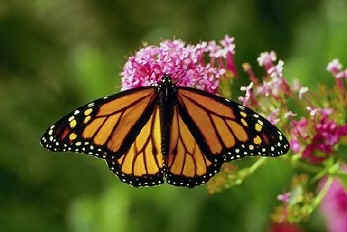Its obvious that land use impacts nature - that is why Republicans created the conservation movement over 100 years ago, and the Lacey Act also. Yet sometimes researchers who want to make the case put the cart before the horse. They engage in statistical data dredging. And that is what happened here. The authors monitored a few local sites and estimated the numbers of butterflies. Then they did a regression analysis to link that to county-wide application of glyphosate. And Texas weather. And Mexico populations (where the real issue is.) Yet rather than focusing on what we know is the problem, Mexico, they implicate one herbicide in Illinois.

Credit: www.monarchbutterflyusa.com
It's a jumble of variables that no statistical analysis can accommodate. They want to implicate local land use - but one pesticide, and only when it was used less, from 1994-2003 - along with seasonal changes in another state to create a model that finds Monarch butterflies are in peril.
The result? Site-specific abundance of Monarchs averaged approximately one fewer per site. Hardly definitive.
Glyphosate is an off-patent product but environmental activists have targeted the agriculture company Monsanto as the culprit behind it in their fundraising campaigns. The authors are academic biologists and don't express any financial conflicts of interest, but it is well-known that money is not the only conflict of interest. Recent efforts by activist groups to have pro-science consumer groups like American Council on Science and Health banned from USA Today and Wall Street Journal have failed but they seem to have had more success in Google News - an insider at Google donates millions of dollars to Natural Resources Defense Council (NRDC) each year, so it is entirely plausible that the word came down to have certain science sites considered "fake news", even if the content is written by scientists and doctors. The American Council on Science and Health page on Wikipedia was also hacked to claim that it is a "pro-industry" group, which is the identical verbiage that political activist sites like Sourcewatch use, and the same anti-science activist who hacked the Wikipedia page also deleted the page for Science 2.0 founder Hank Campbell, who now runs the ACSH organization.
So clearly conflicts of interest can be subtle. Academics have engaged in anti-private sector science for the last generation and the line between corporate giving and private giving is slight. NRDC, enabled by a top-level insider, holds numerous fundraising campaigns at Google, yet gets no money directly from Google so NRDC can claim they have no corporate funding from Google, but it's naive to pretend employees are not pressured to donate. We'll know if we get banned for noting the possibility about where Google News is landing. The Science 2.0 Wikipedia page has already been hacked beyond recognition, but by Germans trying to steal the name and make money on it, not environmentalists.
Clearly when papers like this appear to be targeting the farming community, even in low impact factor journals, it needs to be asked why we don't broaden conflict of interest disclosures beyond direct funding sources.
Citation: Sarah P. Saunders, Leslie Ries, Karen S. Oberhauser, Wayne E. Thogmartin, Elise F. Zipkin, 'Local and cross‐seasonal associations of climate and land use with abundance of monarch butterflies Danaus plexippus', Ecography, DOI: 10.1111/ecog.02719





Comments